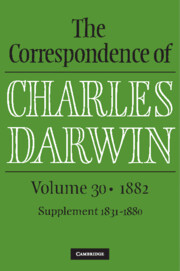Refine search
Actions for selected content:
10296 results in History of science: general interest
Corrigenda
-
- Book:
- The Correspondence of Charles Darwin
- Published online:
- 20 January 2023
- Print publication:
- 26 January 2023, pp 440-494
-
- Chapter
- Export citation
Biographical Register
-
- Book:
- The Correspondence of Charles Darwin
- Published online:
- 20 January 2023
- Print publication:
- 26 January 2023, pp 511-624
-
- Chapter
- Export citation
Frontispiece
-
- Book:
- The Correspondence of Charles Darwin
- Published online:
- 20 January 2023
- Print publication:
- 26 January 2023, pp 1-1
-
- Chapter
- Export citation
Illustrations
-
- Book:
- The Correspondence of Charles Darwin
- Published online:
- 20 January 2023
- Print publication:
- 26 January 2023, pp viii-viii
-
- Chapter
- Export citation
Notes on Manuscript Sources
-
- Book:
- The Correspondence of Charles Darwin
- Published online:
- 20 January 2023
- Print publication:
- 26 January 2023, pp 667-670
-
- Chapter
- Export citation

The Correspondence of Charles Darwin
-
- Published online:
- 20 January 2023
- Print publication:
- 26 January 2023
Chapter 2 - The Contraband Tobacco Trade With Spanish America: Tierra Firme and Hispaniola
-
- Book:
- Portuguese and Amsterdam Sephardic Merchants in the Tobacco Trade
- Published by:
- Anthem Press
- Published online:
- 17 October 2023
- Print publication:
- 17 January 2023, pp 33-62
-
- Chapter
- Export citation
List of Figures
-
- Book:
- Portuguese and Amsterdam Sephardic Merchants in the Tobacco Trade
- Published by:
- Anthem Press
- Published online:
- 17 October 2023
- Print publication:
- 17 January 2023, pp v-v
-
- Chapter
- Export citation
Chapter 5 - Conclusion
-
- Book:
- Portuguese and Amsterdam Sephardic Merchants in the Tobacco Trade
- Published by:
- Anthem Press
- Published online:
- 17 October 2023
- Print publication:
- 17 January 2023, pp 127-146
-
- Chapter
- Export citation
Preface
-
- Book:
- Portuguese and Amsterdam Sephardic Merchants in the Tobacco Trade
- Published by:
- Anthem Press
- Published online:
- 17 October 2023
- Print publication:
- 17 January 2023, pp vi-x
-
- Chapter
- Export citation
Chapter 3 - Portuguese Merchants and The Tobacco Trade With Tierra Firme
-
- Book:
- Portuguese and Amsterdam Sephardic Merchants in the Tobacco Trade
- Published by:
- Anthem Press
- Published online:
- 17 October 2023
- Print publication:
- 17 January 2023, pp 63-98
-
- Chapter
- Export citation
Bibliographic Notes
-
- Book:
- Portuguese and Amsterdam Sephardic Merchants in the Tobacco Trade
- Published by:
- Anthem Press
- Published online:
- 17 October 2023
- Print publication:
- 17 January 2023, pp 147-150
-
- Chapter
- Export citation
Chapter 1 - Portuguese and Amsterdam Sephardic Merchants in The Tobacco Trade in The Early Seventeenth Century
-
- Book:
- Portuguese and Amsterdam Sephardic Merchants in the Tobacco Trade
- Published by:
- Anthem Press
- Published online:
- 17 October 2023
- Print publication:
- 17 January 2023, pp 1-32
-
- Chapter
- Export citation
Frontmatter
-
- Book:
- Portuguese and Amsterdam Sephardic Merchants in the Tobacco Trade
- Published by:
- Anthem Press
- Published online:
- 17 October 2023
- Print publication:
- 17 January 2023, pp i-ii
-
- Chapter
- Export citation
Index
-
- Book:
- Portuguese and Amsterdam Sephardic Merchants in the Tobacco Trade
- Published by:
- Anthem Press
- Published online:
- 17 October 2023
- Print publication:
- 17 January 2023, pp 151-157
-
- Chapter
- Export citation
Contents
-
- Book:
- Portuguese and Amsterdam Sephardic Merchants in the Tobacco Trade
- Published by:
- Anthem Press
- Published online:
- 17 October 2023
- Print publication:
- 17 January 2023, pp iii-iv
-
- Chapter
- Export citation
Chapter 4 - Portuguese Merchants and The Tobacco Trade With Hispaniola
-
- Book:
- Portuguese and Amsterdam Sephardic Merchants in the Tobacco Trade
- Published by:
- Anthem Press
- Published online:
- 17 October 2023
- Print publication:
- 17 January 2023, pp 99-126
-
- Chapter
- Export citation
Colouring flowers: books, art, and experiment in the household of Margery and Henry Power
-
- Journal:
- The British Journal for the History of Science / Volume 56 / Issue 1 / March 2023
- Published online by Cambridge University Press:
- 13 January 2023, pp. 21-43
- Print publication:
- March 2023
-
- Article
-
- You have access
- Open access
- HTML
- Export citation
Antonio Stoppani's ‘Anthropozoic’ in the context of the Anthropocene
-
- Journal:
- The British Journal for the History of Science / Volume 56 / Issue 1 / March 2023
- Published online by Cambridge University Press:
- 13 January 2023, pp. 103-114
- Print publication:
- March 2023
-
- Article
-
- You have access
- Open access
- HTML
- Export citation

A Narrative of Cultural Encounter in Southern China
- Wu Xing Fights the 'Jiao'
-
- Published by:
- Anthem Press
- Published online:
- 10 January 2023
- Print publication:
- 13 September 2022
